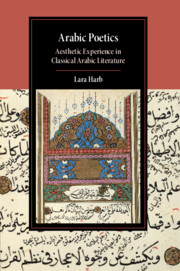Book contents
- Arabic Poetics
- Cambridge Studies in Islamic Civilization
- Arabic Poetics
- Copyright page
- Dedication
- Contents
- Preface
- Acknowledgments
- Note on Dates, Translations, Transliterations, and Names
- Introduction
- 1 Wonder
- 2 Wonder in Aristotelian Arabic Poetics
- 3 Discovery in Bayān
- 4 Metaphor and the Aesthetics of the Sign
- 5 Naẓm, Wonder, and the Inimitability of the Quran
- Epilogue
- Conclusion
- Bibliography
- Index
- Other Titles in the Series
4 - Metaphor and the Aesthetics of the Sign
Published online by Cambridge University Press: 24 April 2020
- Arabic Poetics
- Cambridge Studies in Islamic Civilization
- Arabic Poetics
- Copyright page
- Dedication
- Contents
- Preface
- Acknowledgments
- Note on Dates, Translations, Transliterations, and Names
- Introduction
- 1 Wonder
- 2 Wonder in Aristotelian Arabic Poetics
- 3 Discovery in Bayān
- 4 Metaphor and the Aesthetics of the Sign
- 5 Naẓm, Wonder, and the Inimitability of the Quran
- Epilogue
- Conclusion
- Bibliography
- Index
- Other Titles in the Series
Summary
Chapter 4 focuses on discussions of metaphor (istiʿāra), figurative speech (majāz), and metonymy (kināya). It demonstrates how theories about the beauty of these figures were also driven by an underlying aesthetic of wonder. The process that leads to wonder in these figures, which come to form the pillars of the “science of elucidation” (ʿilm al-bayān), differs from simile and other rhetorical figures. Their beauty lies in the very fact that the word employed figuratively (in metaphor) or implicitly (in metonymy) distances its intended meaning by signifying it indirectly. This is inherently more poetic than explicit expressions, according to our medieval authors, because the listener must go through a process of determining the secondary meaning to which a word’s primary signification points. Metaphor, like simile, therefore, requires the listener to go through an experience of “discovery.” The experience in this case, however, takes place through signification. The chapter thus unveils a medieval Arabic aesthetic theory of signs and signification.
- Type
- Chapter
- Information
- Arabic PoeticsAesthetic Experience in Classical Arabic Literature, pp. 171 - 202Publisher: Cambridge University PressPrint publication year: 2020



